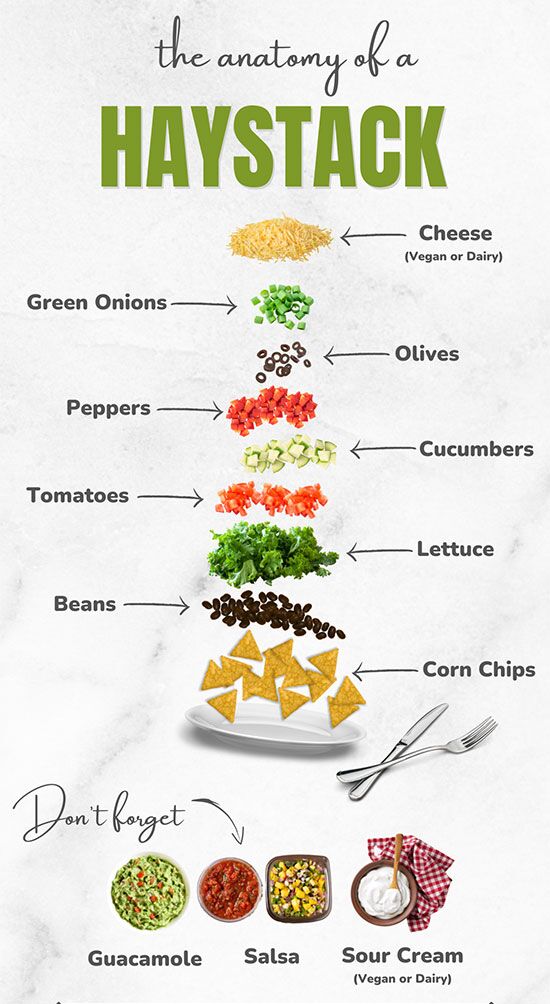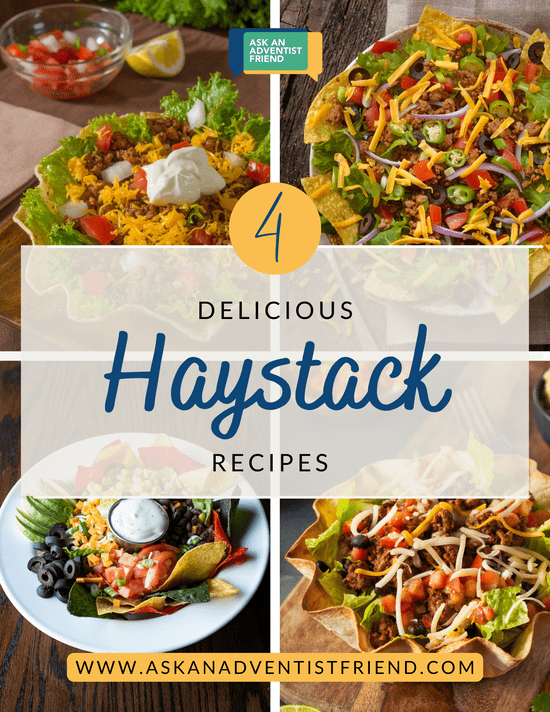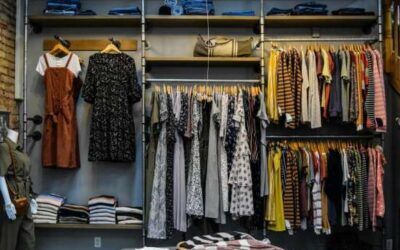If you’ve ever heard Seventh-day Adventists mention “haystacks,” they’re probably not talking about literal stacks of hay.
Haystacks are basically a taco salad—with an Adventist spin on it! Most versions are vegetarian and offer an endless combination of tasty toppings. We eat them often because they’re healthy, scrumptious, and easy to make.
But where exactly did haystacks come from? And who came up with such an unusual name?
Get to know more about this interesting part of Adventist culture in the following sections:
Let’s dig in!
What are haystacks?
Haystacks are a customizable, healthy, and delicious meal often served at Adventist gatherings. They have all the major components of a taco salad for people to assemble themselves. We typically start our haystacks with a bed of corn or tortilla chips, followed by lettuce, beans, cheese, salsa, and sour cream.
Most Adventists make their haystacks vegetarian.
But the great thing about this meal is that it’s customizable. You can make it light or hearty and use any toppings you want for a variety of flavors and textures.
Some might opt for fresh ingredients from the grocery store, but for those on a budget, canned goods work just as well. They don’t require much prep work—you only have to heat up a couple of ingredients. From there, it’s just a matter of placing the toppings in different bowls and letting your guests put it together.
The history of haystacks
The idea for haystacks all began with an Adventist woman named Ella May Hartlein who loved Mexican-inspired food.1
In the 1950s Mrs. Hartlein lived in Arizona, where she and her family enjoyed a variety of Mexican cuisine. But they eventually moved to the northeast, where she couldn’t find many Mexican restaurants.2
That’s when she decided to cook up a little something herself.
She first showcased her dish at a local picnic, and it was an instant hit! After that, it was called “the Hartlein special” until it was given the name “haystacks.”3
How this name came about is still a mystery.
But it’s not hard to guess that haystacks got their name from the way they’re shaped. A big mound of lettuce and crispy corn chips—plus all the toppings—might remind you of a stack of hay.
Turns out, all those toppings do more than add taste. Adventists have some other good reasons for eating them.
Why Adventists eat haystacks
Haystacks are a great meal to have if you’re looking for something quick, easy, and inexpensive. And Adventists especially enjoy them because they offer a healthy meal that coincides with our desire to care for our bodies.

One principle we hold dear is the principle of healthy living. That’s why many of our dishes are plant-based or vegetarian—haystacks included. Plant foods are full of nutrients to effectively fuel our bodies.
Here are just a couple of examples of what you’ll find in haystacks:
- Tomatoes, avocados, and certain beans are high in potassium.4
- Bell peppers are high in vitamin A.5
- Beans and leafy greens are high in6 calcium.
Not to mention that the whole dish is high in fiber and low in cholesterol (or even cholesterol-free if you’re making a vegan version). Beans make it a great protein option, too (especially for vegetarians).
Although not all Adventists are vegetarian, many have benefited from these plant-based benefits. In fact, Adventists are some of the longest living people in the world, mainly because of what we eat.7
Healthy eating matters to us because we want to care for our bodies, which the Bible says are temples of the Holy Spirit:
“Or do you not know that your body is the temple of the Holy Spirit who is in you, whom you have from God, and you are not your own? For you were bought at a price; therefore glorify God in your body and in your spirit which are God’s” (1 Corinthians 6:19–20, NKJV).
Taking care of our bodies is a way to thank God for all He’s done for us. Through healthy habits, we glorify Him, serve Him better, and experience a higher quality of life.
Try haystacks for a simple and healthy meal
Haystacks demonstrate that eating healthy doesn’t have to be difficult or expensive. Something as simple and cheap as this Adventist classic can turn canned vegetables into a satisfying meal you’ll look forward to having again and again.
And it’ll put you on the path to trying some other healthy and delicious meals!
Want the ultimate guide to practical Adventist eating? Look no further than our Adventist nutrition article for practical tips on staying healthy and living longer.
4 Mouthwatering Haystack Recipes
Interested in making haystacks at home? We’ve got four tasty recipes just for you!
Each of these recipes serves about six people. Because they are so simple, they require little to no prep time. Put all of the ingredients in separate bowls so each person can add whichever toppings they want.
Place any perishable leftovers in airtight containers in the fridge. Most of your toppings should last about a week.
The Original
- 4 bags (262 g) of Fritos corn chips
- 1 large can (40.5 oz) of cooked kidney beans
- 1 package (340 g) of veggie taco meat
- 2 bags (227 g) of shredded iceberg lettuce
- 1 small can (6 oz) of sliced black olives
- 1 diced tomato
- 1 diced onion
- 1 bag (226 g) of shredded cheese (dairy or plant-based)
- 1 container (16 oz) of sour cream (dairy or plant-based)
- 1 jar (16 oz) salsa
- 1 container (16 oz) of guacamole
Instructions: Heat up the kidney beans and veggie taco meat. Get a large dinner plate and layer on the ingredients—corn chips first, then the beans, taco meat, lettuce, shredded cheese, vegetables, and toppings. You can use your fork or corn chips to scoop up your haystack.
Pinto Bean Haystack
- 2 large bags of lime tortilla chips
- 3 cups of cooked white rice
- 2 cans (16 oz) of cooked pinto beans
- 1 jar (45 oz) of warm Ragu pasta sauce (tomato, garlic, and onion flavor)
- 1 bag (226 g) of shredded cheese (dairy or plant-based)
- 1 container (16 oz) of sour cream (dairy or plant-based)
- 1 container (16 oz) of guacamole
Instructions: Heat up the white rice, pinto beans, and Ragu sauce. Get a large plate and stack the white rice, pinto beans, Ragu sauce, shredded cheese, sour cream, and guacamole. Mix these ingredients together on your plate and scoop them up with your lime tortilla chips.
Southern Special
- 4 bags (262 g) of Fritos chili cheese corn chips
- 1 can (16 oz) of grilled corn kernels
- 3 cups Spanish rice
- 1 sautéed onion
- 2 sautéed bell peppers
- 2 cans (16 oz) of cooked black beans
- 1 jar (16 oz) of warm queso (or 2 cups of homemade vegan cheese sauce)
- 1 container (16 oz) of sour cream (dairy or plant-based)
- 1 jar (16 oz) of salsa
- 1 container (16 oz) of guacamole
Instructions: Cook the corn, Spanish rice, onions, and peppers. Heat up the black beans and queso. Get a big plate and layer on the ingredients—first with the corn chips, then the Spanish rice, black beans, corn, onions, peppers, and additional toppings. Use a fork or your corn chips to scoop up this tasty meal!
Rainbow Haystacks
- 2 bags of blue corn chips
- 1 can (40.5 oz) of cooked red kidney beans
- 3 cups of cooked brown rice
- 2 bags (227 g) of shredded iceberg lettuce
- 1 sliced head of red cabbage
- 1 diced red onion
- 1 diced tomato
- 2 shredded carrots
- 2 diced orange bell peppers
- 2 bags (226 g) of shredded cheddar cheese (dairy or plant-based)
- 1 bottle (24 oz) of ranch dressing (dairy or plant-based)
- 1 container (16 oz) of sour cream (dairy or plant-based)
- 1 jar (16 oz) of salsa
- 1 container (16 oz) of guacamole
Instructions: Heat up the kidney beans. Get a big plate and stack the toppings. Start with the corn chips, then the rice, beans, lettuce, additional veggies, and final toppings like cheese and sour cream. This is a great option for kids. The rainbow theme can help them overlook the veggies, meaning they get a meal that’s nutritious and fun.
Find a Church
If you’re interested in finding a local Adventist church near you, you can use the Adventist Locator provided by the General Conference of Seventh-day Adventists.
Related Articles
- “Haystacks or Hartlein Special?”Adventist Review, Nov. 26, 2009. https://adventistreview.org/2009-1533/2009-1533-18/archive-2976/.[↵]
- Ibid. [↵]
- Ibid. [↵]
- “10 Foods That Are High in Potassium,” Cleveland Clinic, Feb. 24, 2021. [↵]
- “Vitamin A,” Harvard T.H. Chan School of Public Health. [↵]
- Jennings, Kerri-Ann, “Top 15 Calcium-Rich Foods (Many Are Nondairy),” Healthline, Nov. 4, 2021. [↵]
- “Loma Linda, California,” Blue Zones. [↵]
More Answers
Do Seventh-Day Adventists Have “Rules” For Clothing?
Many religions have guidelines on dress, but what about the Adventist Church? Discover how Adventists choose to dress based on biblical principles.
11 Reasons People Become Seventh-day Adventists
Curious why many people become Adventists? Here are elements of Adventist beliefs, values, and mission often reflected in people’s decisions to join.
What’s the Seventh-day Adventist General Conference Session?
At the General Conference Session, Adventist delegates from around the world gather to assess the state of the organization, pray, and discuss current issues. Here’s how it works.
How Adventists View the End of the World
The end of the world is no fun to think about. But here’s how we can actually find hope and comfort in what’s to come.
What Is an Adventist Medical Missionary?
A medical missionary in the Adventist Church is someone who cares for the medical needs of people as a way of showing the love of Jesus. They may travel to another country, or even just serve in their hometown.
Is the Seventh-day Adventist Church Protestant?
Learn how the beliefs of the Seventh-day Adventist Church align with the “5 solas” of Protestantism.
Are Seventh-day Adventists Evangelicals?
According to its origins and definition, evangelicalism is about following Jesus and the Bible and sharing the Gospel through the way we live our lives. Adventists wholeheartedly harmonize with these principles.
Could Anything Keep Me from Becoming an Adventist?
We are each saved through Christ. But when it comes to church membership, are there certain beliefs or expectations to become an Adventist?
Do Seventh-day Adventists Have “Rules”?
We uphold principles we believe will help us maintain a closer relationship with Jesus and His Word. Learn how these principles guide Adventist lifestyles.
Do Seventh-day Adventists Have “Rules” For Marriage?
Around the world, many cultures and religions have various marriage traditions, expectations, or even rules when it comes to choosing a partner, planning the wedding, extended family logistics, or a number of other things.
Can a Seventh-day Adventist Marry a Non-Adventist?
Yes. Seventh-day Adventists are not under any official rules that dictate who they can or cannot marry. This is a personal, life-altering decision between the couple and God.
What Adventists Believe About Alcohol and Tobacco Use
The Seventh-day Adventist Church has historically discouraged the use of alcohol and tobacco. Even before the church started in 1863, its leaders were realizing the negative effects of these substances.
Jewelry—Why Do Many Seventh-day Adventists Choose Not to Wear It?
If you walk into a Seventh-day Adventist church service, you might notice that many people aren’t wearing earrings, bracelets, necklaces, or sometimes even wedding rings.
International Pathfinder Camporee
Youth aged 10-15 in the Adventist Church’s global Pathfinder program look forward to the International Camporee every 5 years. This event brings together Pathfinders from around the world for exciting activities.
How Adventists interpret Bible prophecy
Bible prophecy conjures up a variety of emotions in people. For some, it feels exciting or mysterious.
Moviegoers’ Guide to The Hopeful: The Facts Behind the Film
Learn where and when you can watch The Hopeful and how to get tickets. Already seen it? We’ll uncover the real story that inspired this film.
How Are Seventh-day Adventists Different from Other Protestants?
As a Protestant Christian denomination, the Seventh-day Adventist Church regards the Bible as the ultimate guide and looks to Jesus Christ as the only way to salvation. We do have some differences of belief or interpretation when it comes to topics like Bible prophecy, end-time events, the Sabbath, and a person’s state after death.
How Adventists Handle Death and Funerals
Most Seventh-day Adventist funeral services are similar to those of other Protestant denominations, such as Methodists, Baptists, or Presbyterians, but you might find a few differences or unique nuances.
Adventist Culture
Many Seventh-day Adventists adhere to specific lifestyle principles that can make them stand out from those in other Christian denominations. Whether it’s going to church services on Saturday or eating the popular Adventist entrée of “haystacks.”
Do Adventists Observe Easter-Related Holidays?
Jesus Christ’s resurrection, celebrated on many Easter-related holidays, is central to the beliefs of the Seventh-day Adventist Church. And that means we seek every opportunity to remember it.
An Overview of Seventh-day Adventist Higher Education
The Seventh-day Adventist Church has about 118 tertiary schools around the world. Though many of them are within North America, you’ll also find Adventist universities in countries across the world—places like Croatia, Austria, Brazil, Madagascar, and the Philippines.
The Ten Commandments from a Seventh-day Adventist Perspective
Ever eaten a salad and gotten a big piece of green stuck in your teeth? And you didn’t realize it was there until you looked in the mirror? (Because no one ever told you!)
The Benefits of A Seventh-day Adventist Academy
Adventist academies are high schools (grades 9-12) that are owned and operated by the Seventh-day Adventist Church.
Are Seventh-day Adventists Christians?
Yes, the Seventh-day Adventist Church is a Protestant Christian denomination formed in 1863. Just like other Christians, we believe that Jesus Christ is our Savior and seek to follow the principles of the Word of God.
Adventist Movies: Where Faith and Film Meet
The Adventist Church uses film to share our faith and uplift positive values. Learn more about specific Adventist-produced films and where to find them.
Do Adventists Celebrate Christmas?
In general, most Seventh-day Adventists do celebrate Christmas.
Since our denomination doesn’t have specific guidelines about holidays, it’s up to each member to decide whether to celebrate it based on their personal convictions and study of the Bible.
What Does the Bible Say About Modesty
Seventh-day Adventists and Christians in general try to ensure their outward presentation and lifestyle glorify God. This often involves daily habits like the ways we hold conversations, the ways we dress and accessorize, and the ways we regard other people when we’re out and about.
How Do Adventists Make Movie and Music Choices?
How do Adventists decide what music to listen to and which movies to watch? Learn how Bible principles can help us make better entertainment choices.
Does the Seventh-day Adventist Church Believe in Paying Tithe?
Seventh-day Adventists believe in paying tithe and offerings based on the biblical command and our commitment to being wise stewards of God’s resources. These donations help fund the mission of the Adventist Church by supporting pastors, missionaries, church expenses, and evangelistic projects, among other things.
Didn’t find your answer? Ask us!
We understand your concern of having questions but not knowing who to ask—we’ve felt it ourselves. When you’re ready to learn more about Adventists, send us a question! We know a thing or two about Adventists.

































